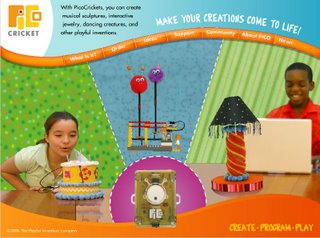 My last post about the PICO Cricket kit and the LEGO Mindstorms brought to the fore thoughts on kids and programming that I have dwelt on ever so often...and the book that started it all (and purportedly inspired many of the early adopters of computers in classrooms as well as legions at the Media Lab in the Lifelong Kindergarten group whose research gave birth to the LEGO Mindstorms and now the PICO Cricket).
My last post about the PICO Cricket kit and the LEGO Mindstorms brought to the fore thoughts on kids and programming that I have dwelt on ever so often...and the book that started it all (and purportedly inspired many of the early adopters of computers in classrooms as well as legions at the Media Lab in the Lifelong Kindergarten group whose research gave birth to the LEGO Mindstorms and now the PICO Cricket).It's been over a quarter of a century since 'Mindstorms' (Seymour Papert's seminal book on kids and computers) took the education world by storm. The book was less about teaching with/about/from computers (the topical tensions of technology integration in schools) as it was about allowing kids to be creative through computers. 26 years on, and we rarely see kids in schools using computers in the way Papert envisioned - children programming computers and acquiring "a sense of mastery over a piece of the most modern and powerful technology" and through this endeavor establishing "intimate contact with some of the deepest ideas from science, from mathematics, and from the art of intellectual model building." Is it because Papert's argument was not compelling enough or is the jury still out on the educational benefits of such an endeavor? Or is it because teachers (the vast majority of them anyway), dare not stray into the realm of "geeks" (the popular (mis)perception of people who can program) - in the belief that such activity is way too "hi-tech" for them. I tend to think that it is the latter.
Fortunately for us all, there are some who have not given up on this powerful idea. The simple easy-to-use LOGO programming environment (that Papert and his colleagues created at the MIT Media Lab) is still alive and kicking, and available through various sources. Microsoft's Kids Programming Language (KPL), while not as easy as LOGO, seems promising. Squeak based on Smalltalk has been around for a while, and Scratch, slated to be Media Lab's latest gift to kids and educators (who care to share Papert's view) is a WYSIWYG, iconic LOGO-like programming environment.
With no apparent dearth of kids programming environments and certainly no shortage of computers (what with the $100 laptop soon to become a reality in the developing world), the need of the hour is to get teachers to start playing around in these easy-to-use, fun programming environments, so that they can get over their irrational fear of communicating with computers, and start seeing the thrilling possibilities of these powerful learning tools in their classrooms.



